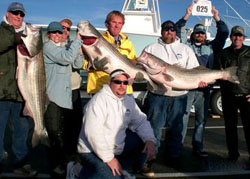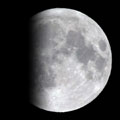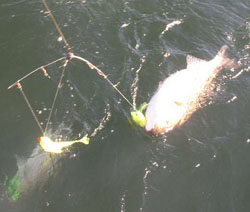Losses and Gains |
||
|
There is a time -- a season -- A time to gain, and a time to lose, Fishing seasons are no different. There comes a time by The ocean temperature plummets Soon they'll disappear until spring. |
|
That's true for striped bass fishing in Virginia. And how! When Jersey’s striper fishing begins to fade in late autumn, Virginia’s is about to take off like no other. Although Jersey’s fall linesider catches are some of the best, Virginia’s in wintertime are the best. Capt. Perry Romig from Topless Fishing Charters, Capt. Steve Richardson from Backlash Sport Fishing and Capt. Bob Robinson from Fin Seeker Sportfishing all agreed. |
||
They all charter for the rockfish from Virginia in winter. These are big stripers Anglers can expect to catch |
 More big rocks are caught in this fishery than anyplace. Photo from Fin Seeker Sport Fishing. |
|
He’s racked up some trips that clobbered limits of 16 rocks that weighed Why are the stripers so much larger on average than anyplace else? Capt. Bob from Fin Seeker believes the reason is because stripers caught from states farther north are a mix of non-migrating, younger, smaller bass and mature, adult, bigger migrators. But most of the bass schooling off Virginia’s coast in winter are the entire population of fully mature, migrating, large stripers that poured down the Eastern Seaboard in fall to spend the winter off Virginia, he said. He also noted that adult stripers from Chesapeake Bay, the world’s best-known bay that holds the linesiders, swim out of the bay during the cold waters of winter and gather in the ocean off the Virginia Coast. That only adds to the population. The migrators first arrive off Virginia near Chincoteague Inlet, north of Virginia Beach. Capt. Perry from Topless, running from the inlet, is poised to intercept them first. But the stripers move up and down the coast from Chincoteague to All three captains pretty much follow the schools wherever they happen to be during a given stretch of those days. |
||
The fish can be located as far But the coast from Chincoteague The schools follow the bait, mainly adult bunker, and different factors can influence where the bait goes. |
 The Backlash |
|
Water temperatures, influenced by air temperatures, are the main factor, When March approaches, the bass shoot up Chesapeake Bay to spawn, and the ocean fishing is finished for Virginians for the season. |
||
A double-header on a trolled |
Apparently the stripers, |
|
They each troll different set ups, usually umbrella rigs, everything from simple rigs with soft plastic lures and Mojo’s to more complicated, custom-made rigs. Describing each of the captain’s custom rigs and trolling spreads can be an article in itself. But Capt. Perry from Topless described his custom rig as including One of the captains said that when a new mate hops aboard the boat, the mate has to learn all about the captain's custom rig. But the idea is that the custom rigs are something the fish never saw before, so when charters fish on the boat, they catch more and bigger bass than the average Joe, of course. During some years the fishing is best late in the season, toward February. During other years the angling is best earlier and shuts off by February. But one thing’s for sure. Virginia’s wintertime striped bass fishing has been the best in the world in the past years. And that season is now. |
||






